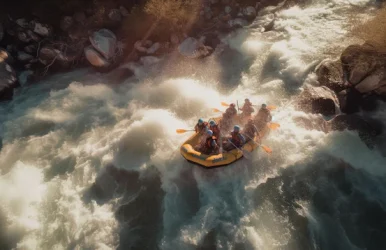10 Best Restaurants On Sanibel Island – Tour And Travel Guide
BY sagnika May 10, 2022
“Traveling satisfies the soul, and food satisfies the tummy.” Many travelers around the world believe in the above statement. Well, there are a lot of travelers around the world who visit Florida to witness vibrant beaches. Moreover, they always remain eager to taste some beautiful dishes from the state's restaurants. The same picture remains for the tourists from the US. People of all ages visit the state for enjoying quality time along the vibrant beaches and the cuisines available in the restaurants. If you are also planning to visit Florida anytime soon, this article can be the reason for your tummy’s happiness. Here, you can study the restaurants on Sanibel Island. It is a location in Florida that you should not miss out on. It homes some fantastic resorts and restaurants where you can spend hours having fun. Moreover, you get some views of the vibrant beaches for free. So, check out the list to learn about the restaurants. However, you should know the best time to visit the state, before that. Best Time To Visit Florida The appropriate time to visit Florida is during the fall and spring. So, you can plan for the trip during the Easter break. At this time, you can enjoy the beaches and the water activities and have food in the best restaurants on Sanibel Islands. As per the months, you can choose April to June and October and November to visit Florida for the best experience. The Top Best Restaurants On Sanibel Island To Know About In 2023 Here is the list of some outstanding restaurants on Sanibel Island. The list also contains some names of the Sanibel Island restaurants on the water. Take a look: 1. Mad Hatter Restaurant If you desire to taste the local cuisine of Florida, the Mad Hatter Restaurant is the place where you must visit. Well, here you can get the taste of all the local spices in the dishes. Therefore, many people think it is the best food joint to visit when on the Sanibel Island. Apart from food, the exciting ambiance of the Mad Hatter Restaurant can make your visit memorable. You can get a glimpse of ‘Alice in Wonderland as you enter the place. Location: 6467 Sanibel, Captiva Road. Dishes To Try: Black Truffle Sea Scallops, Portuguese Oysters, Rack of Lamb. Pocket Pinch: You can expect to have a medium pocket pinch while visiting the Mad Hatter Restaurant. Read more: Top 10 Best Beaches In Florida For Families. 2. Bleu Rendez- Vous Bistro According to the size, the Blue Randez is a Bristo but you can count it among the most buzzing restaurants on Sanibel Islands. It is a new place and has just started its journey seven years back. Meri and Christian Vivet are the founders of the place, and they have made it one of the best French restaurants on the Sanibel Islands. If you are on a casual trip to Florida and just want to have a good time, there is no better place than the Blue Rendez- Vous Bristo. Moreover, you can check out a lot of honeymooners here due to the coziness of the place. The la carte and prix fixe menus are available at this place. So, you can expect to save a lot of money while ordering. Another outstanding thing about this one of the beautiful restaurants on Sanibel Island is the chance to watch chef Christian making food. So, you should always keep a close watch on the kitchen after you place the order. Location: 2430 Periwinkle Way Suite A, Sanibel. Dishes To Try: Escargot In Garlic Butter, Vol-au, Shrimp dish, sherry cream sauce. Pocket Pinch: Medium pocket pinch and some outstanding dishes from this place. 3. Sunset Grill As it is clear from the name, Sunset Grill is one of the top-notch seafood restaurants on the Sanibel Islands. It started its journey shortly and has turned out to be a favorite restaurant. One of the best things about the place is the presence of some unique seafood dishes. So, you can expect to get the authentic taste here. If you are looking for a Sanibel Island restaurant on the beach, you can visit this place. The patio seating in the restaurant allows you to enjoy the sea view while having food. An afternoon visit to this place shall always remain in your heart. Location: 6536 Pine Ave, Sanibel. Dishes To Try: Grill Salmon with Pineapple Sauce, Lump Crab Meat, Half Roasted Chicken with Spices, Wines. Pocket Pinch: Expect not much pocket pinch as you can get every dish at an affordable price. 4. Thistle Lodge Restaurant If you are on a luxury trip to Florida and looking for a place to eat, the Thistle Lodge Restaurant can be your best choice. It is one of the premium restaurants on Sanibel Island. Basically, it is a part of Casa Ybel Resort which is over a hundred years old. Moreover, you can get a chance to check out the award-winning menu and choose some dishes. The best you can do is to order some brunch dishes. Well, this place can be cool if you desire to take some European cuisines. As per the ambiance, you can always choose this place on being a honeymooner. The calmness of this place can always allure you. Location: 2255 W Gulf Dr, Sanibel. Dishes To Try: The Yellowtail Snapper Dish, Chicken with Spinach, Crawfish ragout. Pocket Pinch: As one of the premium Sanibel Island restaurants on the beach, you can expect the price of the dishes to be a bit high compared to other restaurants. 5. Traditions On The Beach Are you the person always looking for traditional places to stay and eat? Well, I guess you have already seen the name above. The Traditions On The Beach is the oldest eatery on Sanibel Island. It has been present in the market since 1895. So, you can consider it the grandfather of all restaurants in the place. Like really! You can consider this restaurant as a traditional grandfather living at your place. From large and comfortable eating spaces to alluring beach views, you can get it all at the Traditions On The Beach. Another thing you must keep in mind is that all the foods are prepared by an award-winning chef here. Location: 3111 W Gulf Dr, Sanibel. Dishes To Try: Colorado Lamb Chops, Filet Mignon Dish, Basil Citrus Sauce with Fried Tuna. Pocket Pinch: The pocket pinch is a bit high for this restaurant too. It is because all the foods are made in a classic way here. You may like to read: 10 Best Things To Do In Navarre Beach, Florida. 6. Malia Island Fusion An underdog among the restaurants on the Sanibel islands, the Malia Island Fusion has gained a rank in this list. So, you can understand how it is one of the best in terms of the quality of food and the ambiance. This restaurant started its journey in late 2018. So, you can consider it still remains in its growth stage. As per the cuisine is concerned, you can try out some outstanding Moroccan dishes at the place. If you are in Florida, you can especially visit this place for dinner. It still remains at a lagging position when it comes to lunch. So, there you get a night activity for your next visit to Sanibel Island Florida. Location: 1100 Par View Drive, Sanibel. Dishes To Try: Black Garlic Shrimp, Cilantro Crema, Cumin-Butter Polenta. Pocket Pinch: Malia is among the middle-top tier restaurants on the Sanibel Islands. So, you should not expect much pocket pinch while visiting this place. 7. IL Cielo IL Cielo is yet another restaurant where you can enjoy a lot of local dishes. It has become one of the favorite restaurants on Sanibel Island because of its food quality. Moreover, the classic ambiance of this place can always turn you awestruck. Do you desire to have an experience of a kingly fine-dine at the most affordable cost? Well, remember that IL Cielo is the best place you can visit. Moreover, if you are a music lover, this is the place where you would want to sit for hours placing orders, one after another. The reason is due to the presence of a live pianist. You can expect him to play a song of your request as you enjoy your food. Location: 1244 Periwinkle Way, Sanibel. Dishes To Try: The Lobster and Local Vegetable Dish, The Gulf-Grouper Dish, Hand made Ravioli. Pocket Pinch: You can expect affordable prices for all the foods present on the IL Cielo menu. However, it might seem a bit high compared to other restaurants. The reason is due to the fine-dine experience this place promises to provide. 8. The Jac The Jac is one of the classic restaurants on Sanibel Islands that went on to the hands of new owners in 2019. It was later known as ‘The Tipsy Turtle’. Well, as of now, the restaurant is on a sabbatical. So, when it opens again, you can always visit it as one of the top restaurants on Sanibel Beach. It is expected that the restaurant authorities shall stick to Chef Philipe Schroder. Otherwise, they would surely look for someone else with the same potential. The best you can do is wait for some more months as the restaurant can again become active soon. Dishes To Try: The Grouper Basket, The Tacos, The Burgers. Pocket Pinch: If you are on a budget Florida trip, you can always visit The Jac after it reopens (Probably, with a new name). This can be the best place where you can have a blast. 9. Sweet Melissa’s Cafe The USA Today has termed Sweet Melissa’s Cafe as one of the leading restaurants on Sanibel Island as well as South USA. So, you can always expect to get good food in the place. You can expect to get both small and large platters in this place. So, it would be better for you to visit this restaurant no matter if it's breakfast, lunch or dinner. As per the claims from the place, you can get outstanding local dishes at this place. Make sure you select your dish, and preferably, it must be a seafood dish. Yet another thing you must not forget is tasting the fine meat dishes that are available in this place. Location: 1625 Periwinkle Way #4402, Sanibel. Dishes To Try: The Crispy Soft-Shelled Crab, Fennel, Pernod Liquor, Pork Belly with Scallops Dish, Sweet Potato Pure Dish. Pocket Pinch: The cost of all dishes in this restaurant is from the medium to high range. So you can get a feel of fine-dine even in this place too. Read more: 10 Best Fishing Charters In Florida To Visit 10. Cip’s Place If you are from the US itself and it is not your first Florida trip, try out Cip’s Place for dining. You can expect to get the best local food here as it is one of the frontline restaurants on Sanibel Island. Well, another thing that you can get here is an ambiance worth remembering. The best you can do here is enjoy the outstanding weather of the place while having some lip-smacking local foods. It is all up to you whether you give this 12-year-old restaurant a try. Location: 2055 Periwinkle Way, Sanibel. Dishes To Try: Ginger Shrimp Stir Fry, Daily Catch Cioppino (On Availableity), Mango Rum Salsa. Pocket Pinch: The pocket pinch on eating at the Cip’s place would be medium as you can find a lot of locals crowding this place. It is undoubtedly one of the most loved restaurants in Sanibel Islands Florida. 11. The Lazy Flamingo The restaurant is known for its unique style and flair across the Sanibel restaurants! The Lazy Flamingo at one point of time was hidden but a gem in Sanibel! But finally it is out in the open and both the locals and the tourists are crazy about the food. Overview: One of the most unique but fun parts is that you can bring your own catch of seafood here and the chefs will cook them for you, Island style! You also need to make sure that the catch is filleted and clean. Enjoy your food with cold beer while getting submerged in southwest Florida’s culture. You will experience the rustic feel especially with the exterior of the building which is pink in color. Location - 1036 Periwinkle Way Sanibel FL Dishes To Try: Do not miss coleslaw, conch chowder, and fish tacos along with fresh mango! You gotta check this place out if you are on Sanibel Island! Pocket Pinch: You will be spending somewhere between the range of $8.59 to $19.33! 12. Traders squarespace-cdn.com Traders as a restaurant features a unique style of dining experience. Food that is available here are coastal inspired dishes. People keep coming back to this restaurant with its beautiful vibe and fun environment. Overview: There is a wide variety of delicious food at the Traders along with an extensive list of wine! The restaurant also has an established collection of signature cocktails and selected options of draft beers. There is a gift shop which is quite fun especially if you are trying to eat outside and bask in the ambiance. You can relax in that environment with established flavors of food along with amazing cocktails. Location - 1551 Periwinkle Way, Sanibel FL 33957. Dishes To Try: Items such as lobster ravioli and pan-blackened Mahi to seared scallops should not be missed. Along with the food, there are cocktails such as Key Lime Martini and Mango MaiTai are some of the drinks you gotta try! Pocket Pinch: The place is popular for delicious yet affordable food with a starting price of $4 and can go up to three digit based on the items ordered! 13. Island Cow prioritymarketing.com Of course, you cannot miss this restaurant if you are looking for a friendly family restaurant! Island Cow has been operated for 20 years by a family with a beautiful ambiance and pretty decor. It is one of the Sanibel restaurants that is quite popular. Overview: The restaurant is perfect as you will find inspirational Old Florida comfort food. You will try the food items from the Caribbean, Key West, and others. You will be fed breakfast, lunch and dinner in the Island Cow. Location - 2163 Periwinkle Way, Sanibel, FL 33957 Dishes To Try: You can eat stuffed french toast and crab cake burger. Some of the best items in the restaurant. You cannot miss the outdoor games, cold drinks and live entertainment in the restaurant! Pocket Pinch: You have to spend around $9.99 to $21.99 based on the item you order in this cow themed restaurant! It also accompanies a bar. Frequently Asked Questions (FAQ): Does Sanibel Island Have Good Food? Yes, Sanibel Island has good food. What Is The Most Fancy Restaurant In Florida? The Bleu Rendez- Vous Bistro is the fanciest restaurant in Florida. How Many Restaurants Are On Sanibel? There are over 50 restaurants on Sanibel Island. Is Sanibel Island Walkable? Yes, the Sanibel Island is walkable. Final Words So, here are the restaurants on Sanibel island you can try on your next trip. There is one task you can do is to check whether The Jac is open or not. Apart from it, you can randomly choose any restaurant given in this list. So, waste no time and set a tour this summer or during the fall. Finally, do not forget to let us know about your experience on the trip. Read Also: 10 Best Places To Travel In May – Travel Guide 10 Best Places To Travel In June – Travel Guide Few Excellent Ways To Get Discount On Hotel Booking











